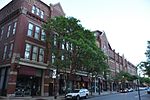Manchester City Library

The Manchester City Library was established in the mid-1850s, and serves the population of Manchester, the largest city in the state of New Hampshire. It is one of twelve libraries in the GMILCS consortium (Greater Manchester Integrated Library Cooperative System) that provides materials and services to the greater Manchester area, and is on the U.S. Department of Interior's National Register of Historic Places, listed under the Victory Park Historic District as a contributing property, one of the four buildings that face the park. Even though the current building was completed in 1914, library services were provided as early as 1844 through a membership-based organization known as the Manchester Atheneum, and then as a public library which was housed in two other buildings. Over the last century, the library has undergone many renovations to maintain the historical integrity of the building. It has continuously provided materials in various formats (print, digital, and multimedia), as well as vital services to the public, including internet access, literacy programs, community events, and educational workshops and classes.
Excerpt from the Wikipedia article Manchester City Library (License: CC BY-SA 3.0, Authors, Images).Manchester City Library
Pine Street, Manchester
Geographical coordinates (GPS) Address Website Nearby Places Show on map
Geographical coordinates (GPS)
| Latitude | Longitude |
|---|---|
| N 42.992222222222 ° | E -71.458611111111 ° |
Address
Manchester City Library
Pine Street 405
03104 Manchester
New Hampshire, United States
Open on Google Maps







